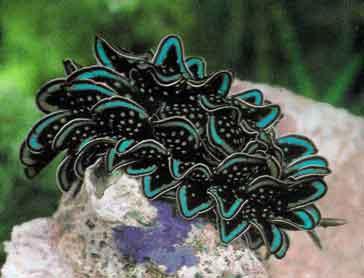Here is my first attempt at using RinsAWay, similar to Solvy. The idea is that you place fibres, scraps of fabric and other objects on the soluble plastic, cover it with another layer of plastic to keep it all in place, then stitch through all the layers to create a kind of fabric. As in the photographs here.

1. The soluble plastic comes on a roll -- you just cut off as much as you need.

2. Next you place the fibres that you want to turn into fabric on the plastic sheet, then cover it with another layer of the plastic. These fibres are the ends of threads I used in my Moon Rock embroidery. I saved them all in a zip-lock bag as I was stitching.

3. Place the sandwich of soluble plastic and fibres in an embroidery hoop to hold it firm.

4. Most people machine stitch through the layers, using a free-hand motion. My ancient sewing machine doesn't have the required darning foot attachment and the tension is a bit suspect, so I chose to hand stitch in a spiral pattern. It was more time consuming, but fun. Next time, I might try a more intricate pattern, more decroative thread and smaller stitches. Or find someone who has a better sewing machine I can borrow.

5. Lastly, I ran the assembly under cold water and dissolved the plastic layers. The resulting lacy mesh is pretty, but quite fragile. It also required several rinses to fully remove the soluble plastic residue, which got all over my hands and the sink. Eewww.
 1. The soluble plastic comes on a roll -- you just cut off as much as you need.
1. The soluble plastic comes on a roll -- you just cut off as much as you need. 2. Next you place the fibres that you want to turn into fabric on the plastic sheet, then cover it with another layer of the plastic. These fibres are the ends of threads I used in my Moon Rock embroidery. I saved them all in a zip-lock bag as I was stitching.
2. Next you place the fibres that you want to turn into fabric on the plastic sheet, then cover it with another layer of the plastic. These fibres are the ends of threads I used in my Moon Rock embroidery. I saved them all in a zip-lock bag as I was stitching. 3. Place the sandwich of soluble plastic and fibres in an embroidery hoop to hold it firm.
3. Place the sandwich of soluble plastic and fibres in an embroidery hoop to hold it firm. 4. Most people machine stitch through the layers, using a free-hand motion. My ancient sewing machine doesn't have the required darning foot attachment and the tension is a bit suspect, so I chose to hand stitch in a spiral pattern. It was more time consuming, but fun. Next time, I might try a more intricate pattern, more decroative thread and smaller stitches. Or find someone who has a better sewing machine I can borrow.
4. Most people machine stitch through the layers, using a free-hand motion. My ancient sewing machine doesn't have the required darning foot attachment and the tension is a bit suspect, so I chose to hand stitch in a spiral pattern. It was more time consuming, but fun. Next time, I might try a more intricate pattern, more decroative thread and smaller stitches. Or find someone who has a better sewing machine I can borrow. 5. Lastly, I ran the assembly under cold water and dissolved the plastic layers. The resulting lacy mesh is pretty, but quite fragile. It also required several rinses to fully remove the soluble plastic residue, which got all over my hands and the sink. Eewww.
5. Lastly, I ran the assembly under cold water and dissolved the plastic layers. The resulting lacy mesh is pretty, but quite fragile. It also required several rinses to fully remove the soluble plastic residue, which got all over my hands and the sink. Eewww.

4 comments:
That's nice, Melody. That solvy you have does take a bit of time to wash out, try hot water next time. I don't think your piece will hold up to cutting into, I think you need some horizontal and vertical lines first. Or maybe a fabric/felt backing and just solvy on the top? Some metallic threads are nice too, especially the ones you bought that your sewing machine just won't look at!
Melody - yep you have the hang of it and I am sure you see the possibilities -
it looks great - only one little thing thing is that perhaps you need a bit more of a grid like structure - like fabric itself
Yes, I would agree, you need a grid, try a spider web pattern next time? But it was a nice experiment. I have never used soluble for hand stitching. If you leave some of the solvy in, the fabric will stay stiff enough to mould into a shape and will also be less likely to unravel.
Melody
I also have found that a grid type of stitching holds the threads together well and you do end up with a needle "lace" .
If you layer your threads on a tulle base,you'll only need one layer (top) of Solvy.
And by doing a grid pattern(not necessarily a regular grid either) you'll find that your cantankerous machine should cope.
(Emmtoo)
Post a Comment